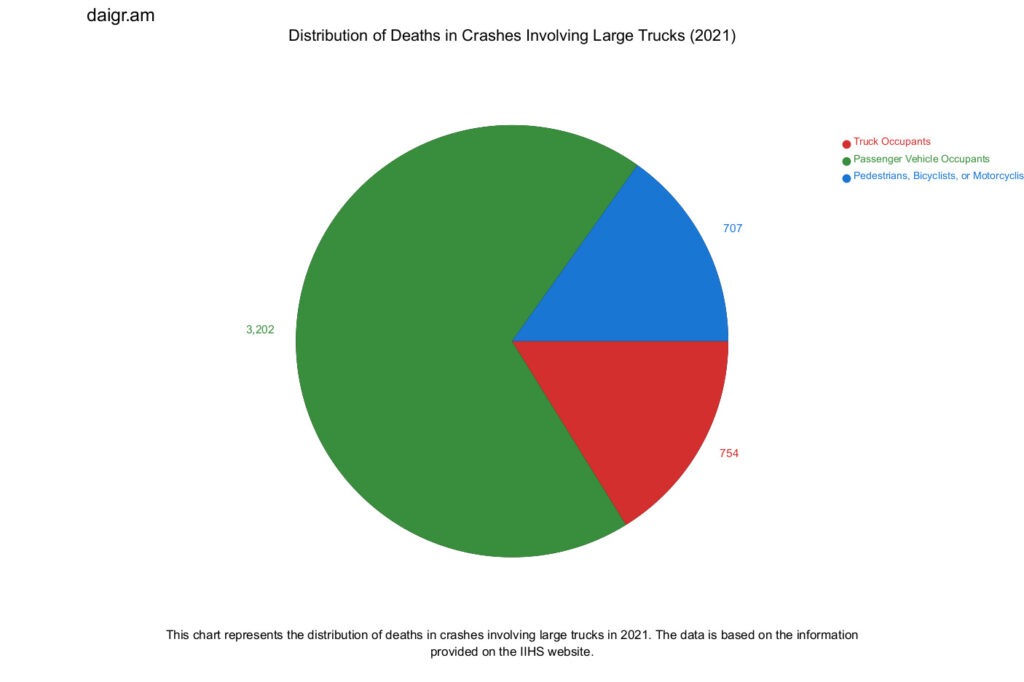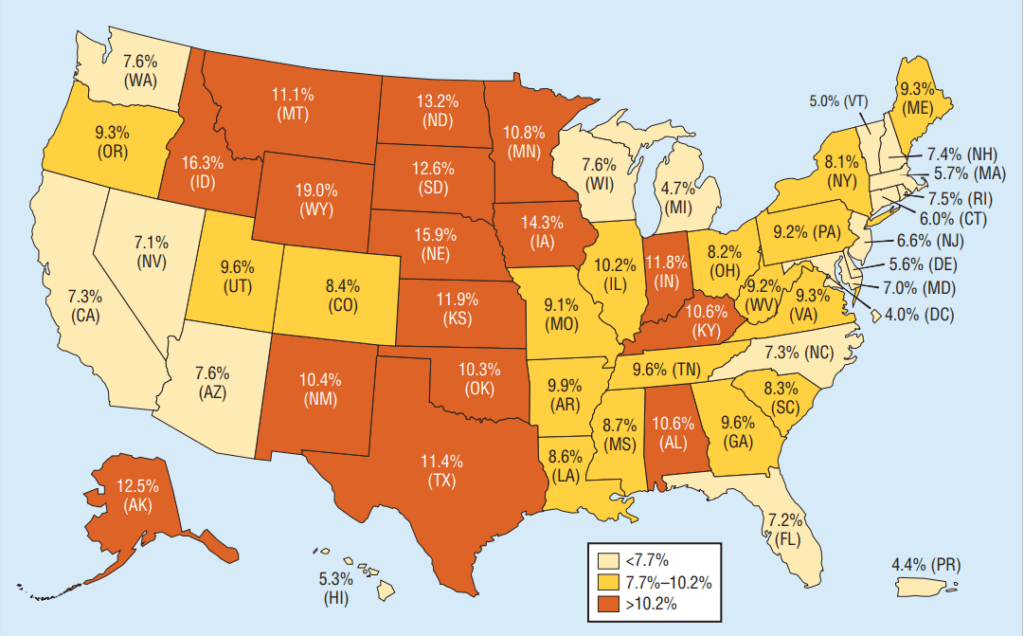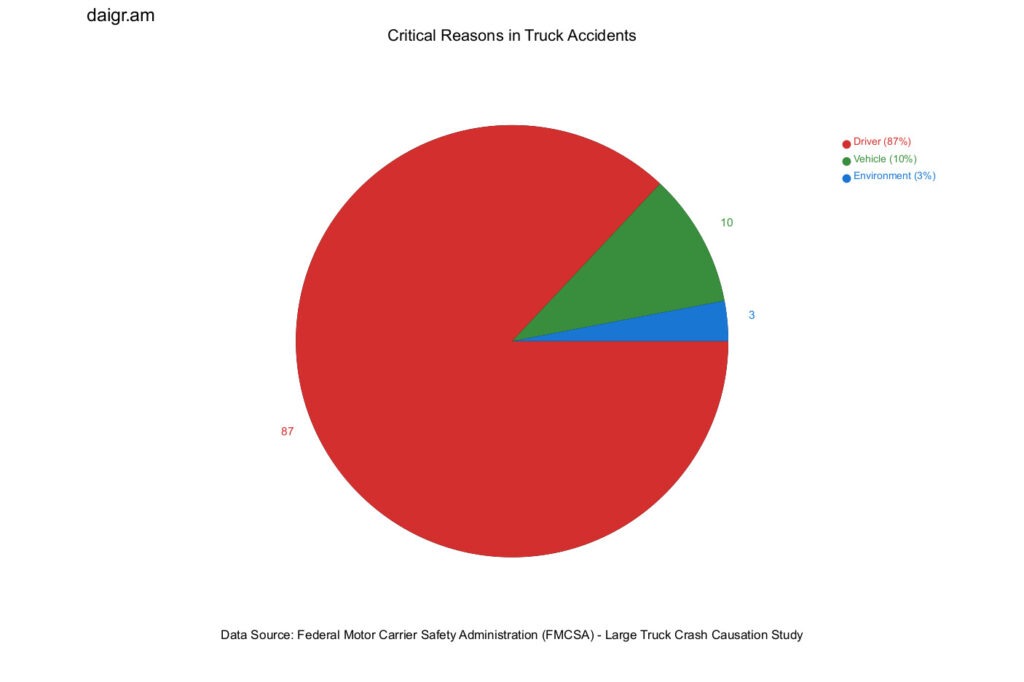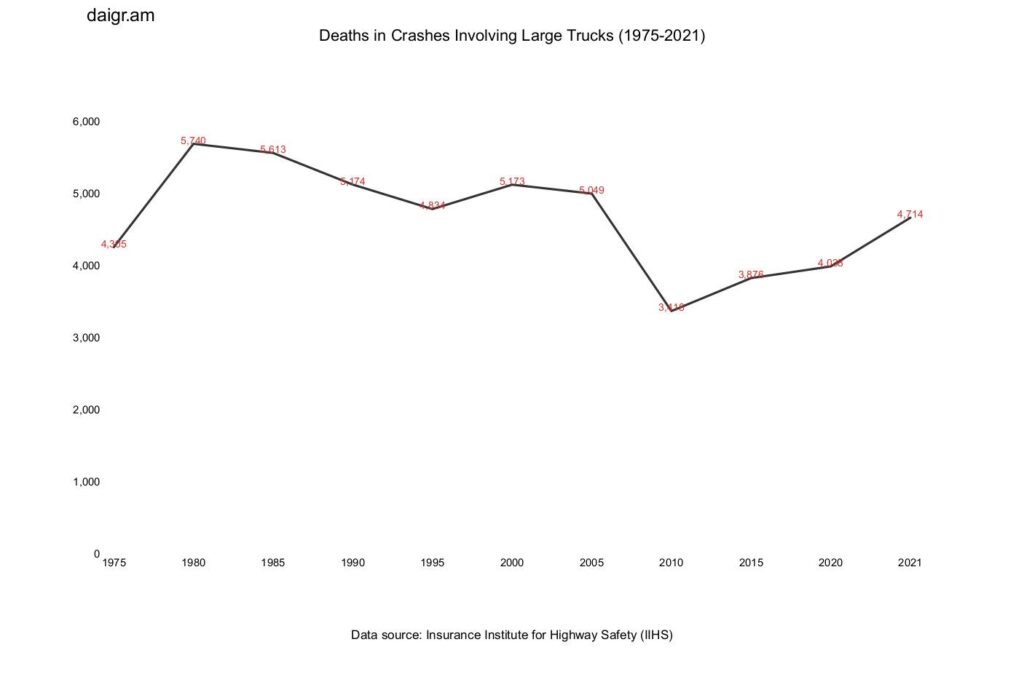New Study: The Role of Trucking Companies in Deadly Accidents
Every year, nearly 13 million trucks travel throughout the United States, carrying the lifeblood of the nation’s economy. But this economic boon comes with a deadly cost: fatal trucking accidents, a growing problem set to become the fifth leading cause of death by 2030. (The National Library of Medicine)
When discussing road traffic injuries and fatalities, it’s crucial to consider the role of trucks and commercial vehicles. Their size and weight often escalate the severity of accidents, with the most vulnerable victims—occupants of other vehicles—bearing the brunt of the impact. According to the National Highway Traffic Safety Administration (NHTSA), the majority of fatalities in crashes involving large trucks are not the truck drivers, but those in other vehicles. This sobering fact underscores the urgent need for improved safety measures and regulations in the trucking industry.
Speak with a personal injury lawyer today. Call: 317-488-5500
The Human Cost of Trucking Accidents
In our role as an Indianapolis truck accident lawyer team, we’ve seen the heart-wrenching aftermath of trucking accidents up close. These incidents aren’t just numbers on a page; they’re real-life tragedies that shatter lives, tear families apart, and leave a path of destruction that often traces back to the negligence of others. This is a nationwide concern that demands our attention.
Take, for example, the tragic story of a man killed last month in Indiana on I-69. He died after his semi-truck crashed into another truck on the highway. The man in the other truck that was hit was taken to the hospital with serious injuries, but fortunately survived the accident.
The graph below, sourced from the Insurance Institute for Highway Safety, paints a grim picture of the distribution of deaths in crashes involving large trucks in 2021. The majority of fatalities are not truck occupants, but rather passenger vehicle occupants and vulnerable road users like pedestrians, bicyclists, or motorcyclists.

This data highlights the disproportionate impact of trucking accidents on other road users, further emphasizing the urgent need for improved safety measures in the trucking industry. Our roads, including those in Indiana, are not immune to reckless driving and inadequate safety measures.
According to 2020 data from the NHTSA, about 11.8% of fatal crashes in Indiana involved a large truck, higher than the nationwide average of 8.9%.

Percentage of Large Trucks Involved in Fatal Crashes, by State, 2020. Source: National Highway Traffic Safety Administration.
In our community, we witness the struggle of surviving families as they grapple with emotional and financial damages, often irreparable due to the loss of a loved one. But when tragedy strikes, how do we determine who is at fault, and what is being done to prevent these fatalities?
Why Do These Accidents Happen?
To mitigate trucking accidents, we must first understand their causes. These incidents often stem from a mix of factors, many of which are preventable with proper safety measures.
Driver fatigue is a real problem in the trucking industry. According to the Federal Motor Carrier Safety Administration (FMCSA), fatigue is a leading cause of trucking accidents. The relentless pressure to meet delivery deadlines can push drivers to the brink, leading to long hours on the road without adequate rest despite what’s established in trucking laws.
But in many cases, accidents attributed to drivers’ responsibility are caused by trucking companies’ negligence. Below is a graph using data from the Large Truck Crash Causation Study conducted by the FMCSA and the NHTSA that shows the cases when the responsibility is assigned to drivers.

The top reasons for truck accidents
Even when the drivers are responsible in most cases (87% in this particular study), the truth is not all causes are the full responsibility of drivers. For example, let’s see what we find inside the critical reasons categorized into drivers’ fault:
- Non-Performance: The driver fell asleep, was disabled by a heart attack or seizure, or was physically impaired for another reason.
- Recognition: The driver was inattentive, was distracted by something inside or outside the vehicle, or failed to observe the situation adequately for some other reason.
- Decision: For example, the driver was driving too fast for conditions, misjudged the speed of other vehicles, or followed other vehicles too closely.
- Performance: For example, the driver panicked, overcompensated, or exercised poor directional control.
These insights reveal that the responsibility for these critical reasons often attributed to drivers lies with the trucking companies and, by extension, the insurance companies that set the terms and conditions. Overspeeding, health issues, falling asleep, and other factors are not solely the fault of the drivers, but are indicative of broader systemic challenges within the industry.
These companies are responsible for ensuring their drivers are well-trained, their vehicles are well-maintained, and safety regulations are strictly adhered to. A failure in any of these areas can lead to accidents, making it a matter of corporate responsibility.
Complete a Free Case Evaluation form now
Are Trucking Companies and Manufacturers Responsible?
The role of trucking companies and the lack of government regulation in trucking accidents cannot be overstated.
They bear significant responsibility for one of the most common causes of these accidents: driver fatigue. Furthermore, they are also accountable for the absence of safety measures that could potentially make these accidents less fatal.
The Misplaced Focus on Driver Responsibility
Trucking accidents are far from trivial incidents; they often result in catastrophic events leading to severe injuries and, in the worst cases, wrongful death. When trucking companies cut corners to save costs, preventable road accidents can devastate entire families.
Yet, the focus of many investigations and reports often falls on the drivers’ responsibility, overshadowing the role of those who are supposed to ensure secure conditions for commercial vehicles and drivers.
The Controversy Surrounding Side Guards
A recent investigation aired on PBS, titled “America’s Dangerous Trucks“, sheds light on the resistance from the American Trucking Association (ATA) to implement safety measures proven to prevent fatalities, such as side guards. The ATA argues that the cost of installing these guards would be prohibitive and could cause operational issues, particularly affecting small companies that can’t afford it.
This resistance persists despite research suggesting that side guards could save hundreds of lives each year. This figure is significantly higher than the 17.2 deaths per year estimated in the NHTSA report. The report also estimates that it would cost between $973 million and $1.2 billion to implement side guards on all large trucks.
This is despite the existence of cost-effective designs, such as the one proposed by mechanical engineer Aaron Kiefer. Despite promising tests and the potential for easy manufacturing, Kiefer hasn’t sold a single guard, attributing this to poor implementation of safety regulations.
Click to contact us today
The Need for Improved Reporting and Regulation
The fatality of trucking accidents has increased in the last years, despite the efforts to make roads safer for all drivers and passengers. Only in the last year, deaths in crashes involving large trucks have grown by almost 17%, according to IIHS report.

The underreporting of underride crashes and fatalities is a significant issue that hampers the implementation of safety measures. According to a report by the Government Accountability Office (GAO), only 17 out of 50 states have a field on their police accident report to indicate if an underride crash occurred. This suggests that these crashes are likely underreported, leading to a significant gap in the data that informs policy and regulation.
The GAO has called for more research and investigation into the issue of side underride crashes, which are the most fatal ones. They have also recommended that the National Highway Traffic Safety Administration (NHTSA) improve its counting procedures.
This underreporting has significant implications for policy and regulation, as it can lead to an underestimation of the problem and a lack of urgency in implementing safety measures such as side guards. The need for improved reporting is not just about numbers; it’s about lives.
Each underreported crash represents a missed opportunity to learn, improve safety measures, and prevent future tragedies.
According to various studies and official data, several regulations could significantly reduce the number of fatalities in trucking accidents. These include:
- Implementation of side guards: As per the Volpe Center, a part of the U.S. Department of Transportation, side guards can effectively reduce the risk of fatality in side-impact collisions with trucks.
- Stricter hours of service regulations: The FMCSA has regulations limiting driving hours to prevent driver fatigue, a leading cause of accidents. Stricter enforcement of these regulations could save lives.
- Regular vehicle maintenance: Ensuring that trucks are well-maintained and that issues such as brake problems and tire issues are addressed promptly can prevent accidents, as per the FMCSA.
- Advanced driver assistance systems (ADAS): Technologies such as automatic emergency braking and lane departure warnings can help prevent accidents. The Insurance Institute for Highway Safety (IIHS) has found that trucks equipped with forward collision warning and automatic emergency braking have 44% fewer rear-end crashes than trucks without these systems.
If the data available cannot be trusted and regulations are inadequately implemented, how can we effectively implement these security measures to safeguard lives?
How Law Firms Play A Role After Truck Accidents
Lee Christie, Managing Partner at Christie Farrell Lee & Bell and member of several trucking litigation groups, such as the AAJ, ATAA, and APITLA, explains that “the insurance companies and the trucking companies have teams that are out on the scene, immediately interviewing witnesses, gathering evidence, destroying evidence, or preserving evidence.” Law firms help victims of truck related injuries or deaths fight the trucking companies to ensure proper justice is served. Law firms experienced in these types of cases, like Christie Farrell Lee & Bell, are going to have a team of their own. For example, Lee also mentions that “part of the process is incorporating an accident reconstructionist and investigators to get out to the scene of the accident because all semi-tractors have black boxes, and there’s an amazing amount of data that’s available on the black box or the electronic control module.”
Each case we’ve won has a unique story behind it, a narrative of human resilience and the quest for justice. Take, for instance, the case that led to an $18.5M settlement. The victim, a truck collision survivor, was left with a traumatic brain injury. This case wasn’t just about the settlement; it was about highlighting the devastating human cost of such accidents and the firm’s unwavering commitment to seeking justice.
The information found in this study is not only key to solving specific cases but also preventing future fatal trucking accidents in America.
Call 317-488-5500 or complete a Free Case Evaluation form



